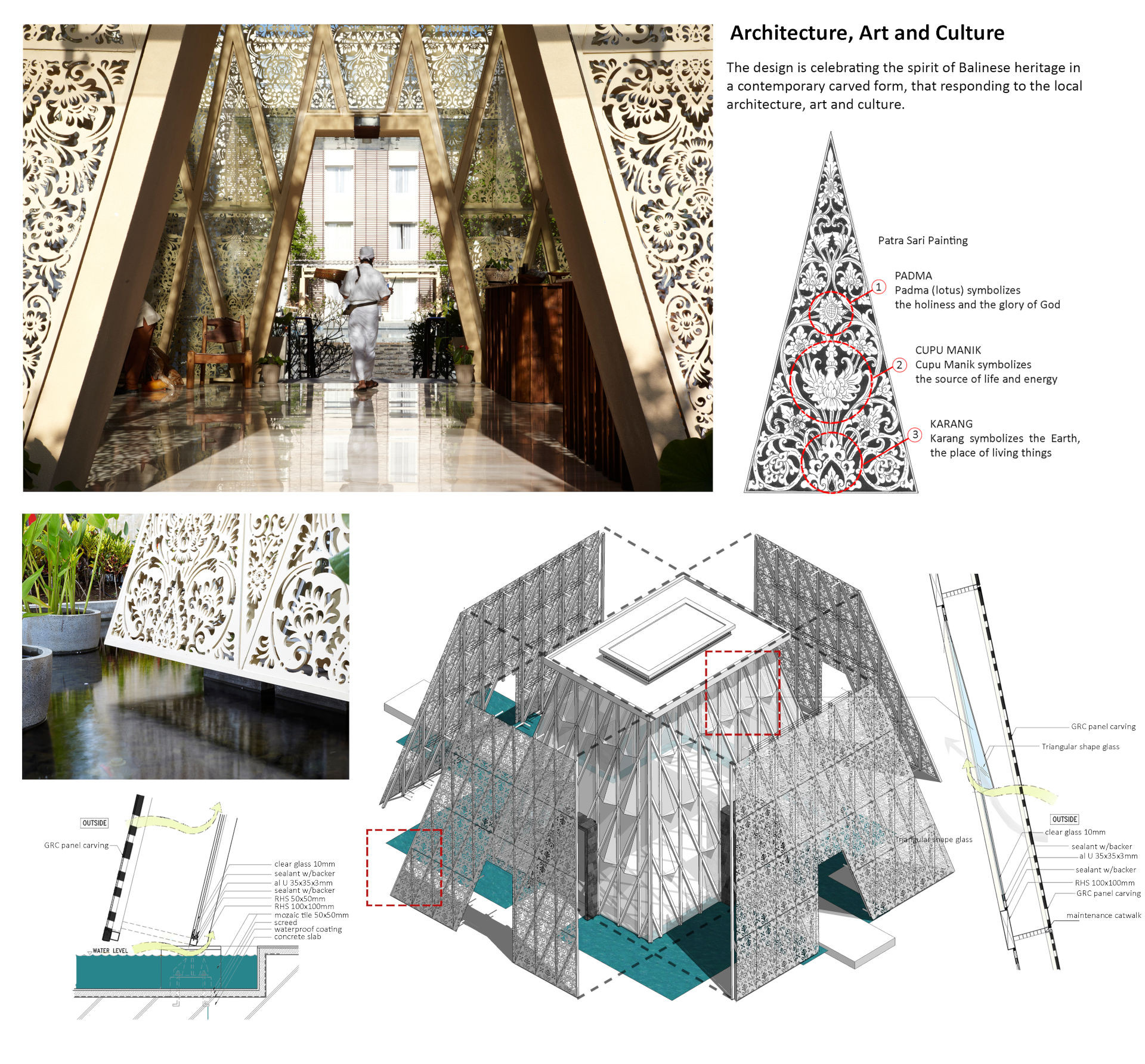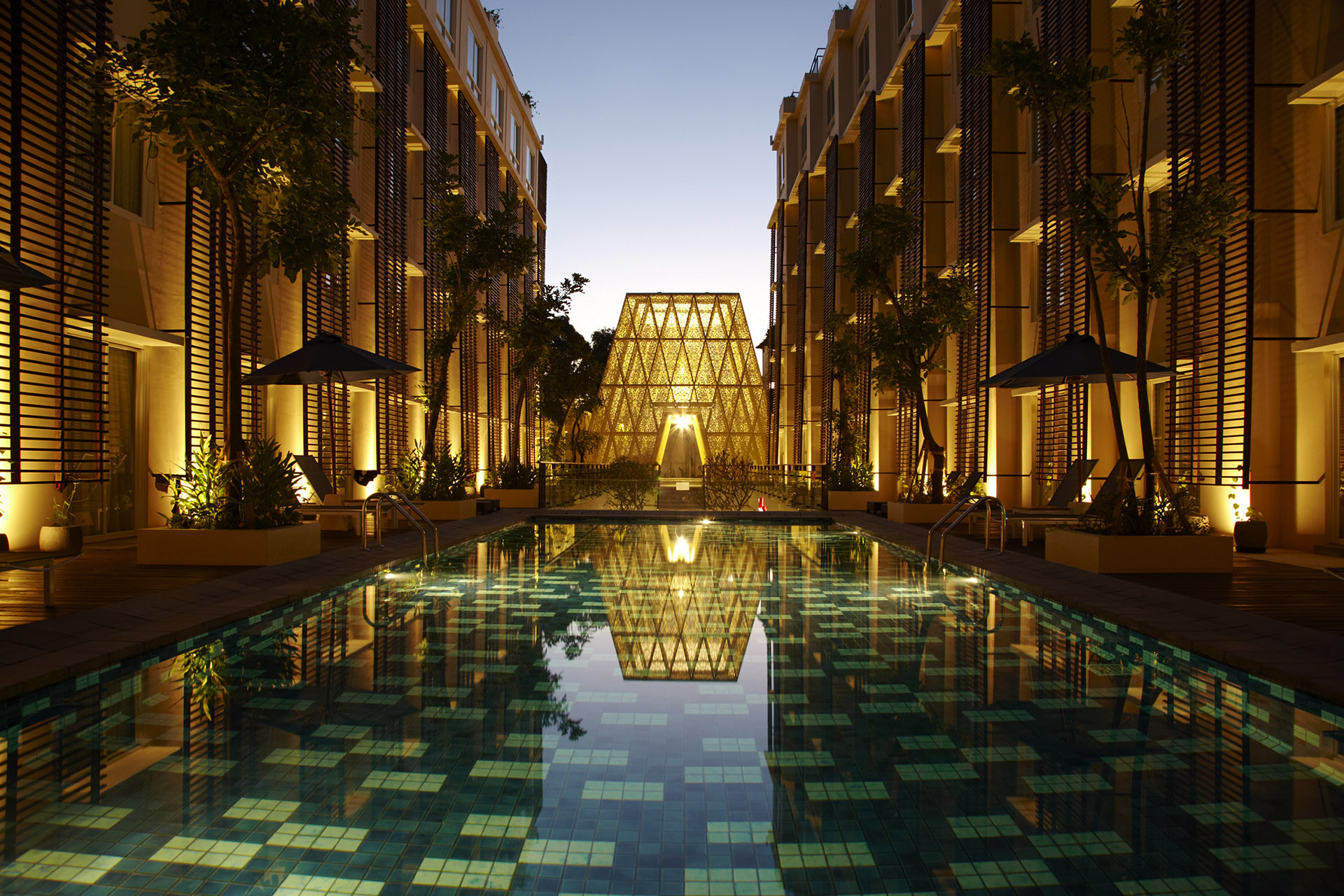ANANTA LEGIAN HOTEL - Contemporary Inculturation
CONTEMPORARY INCULTURATION
Ananta Hotel Legian – Legian, Bali
Site Area : 3.133 m2
Building Area : 8.477 m2
Client : PT Realestat Perdana
Function : Hotel
Year of Completion 2012
The Ananta Legian Hotel desiged by Airmas Asri is located near Legian Beach, Bali. The design referred to Balinese Legong dance and pura, a Balinese building type which serves for religious purposes. The design process of the hotel involved an attempt to comprehend the genius loci of the site which would bring the architect team to a new understanding on Balinese architecture.
Technical and cultural aspects are represented to combinations of shapes and carvings which are evident at the lobby area. The lobby area also serves as focal point.
The carvings are based on a painting by I Wayan Lungguh, Patra Sari, which depicts an ambience of sacredness. Combined with natural light which penetrate into the lobby, the carvings create a strong and pleasing spatial character an ambience.

Louis Isidore Kahn considered light as the “giver of all presences”. Light – like its by product, shadow – is a profound material to create architectural presence. The adaptation of I Wayan Lungguh’s painting on the façade’s carving creates a combination of light and shadow which best owes the lobby space with its ambience. Patterned shadows are visible on the floor and walls. At night, interior lights cast the lights from within and through the carvings. This turns the mass of the lobby into a sort of contemporary sculpture which still refers to the Balinese sense of delight.
The open space area which called latar in traditional Balinese architecture vocabulary is situated in the middle of the hotel building area. It functions with its facilities such as swimming pool, restaurant, café and function hall. At the corridor lattices made out of metal frameworks function to protect the area from rain as well as to avoid massive look on tha façade. In general, Ananta Hotel Legian combines local sensitivity and functionalism in order to create a contemporary work of architecture.
Ananta Hotel Legian – Legian, Bali
Site Area : 3.133 m2
Building Area : 8.477 m2
Client : PT Realestat Perdana
Function : Hotel
Year of Completion 2012
The Ananta Legian Hotel desiged by Airmas Asri is located near Legian Beach, Bali. The design referred to Balinese Legong dance and pura, a Balinese building type which serves for religious purposes. The design process of the hotel involved an attempt to comprehend the genius loci of the site which would bring the architect team to a new understanding on Balinese architecture.
Technical and cultural aspects are represented to combinations of shapes and carvings which are evident at the lobby area. The lobby area also serves as focal point.
The carvings are based on a painting by I Wayan Lungguh, Patra Sari, which depicts an ambience of sacredness. Combined with natural light which penetrate into the lobby, the carvings create a strong and pleasing spatial character an ambience.

Louis Isidore Kahn considered light as the “giver of all presences”. Light – like its by product, shadow – is a profound material to create architectural presence. The adaptation of I Wayan Lungguh’s painting on the façade’s carving creates a combination of light and shadow which best owes the lobby space with its ambience. Patterned shadows are visible on the floor and walls. At night, interior lights cast the lights from within and through the carvings. This turns the mass of the lobby into a sort of contemporary sculpture which still refers to the Balinese sense of delight.
The open space area which called latar in traditional Balinese architecture vocabulary is situated in the middle of the hotel building area. It functions with its facilities such as swimming pool, restaurant, café and function hall. At the corridor lattices made out of metal frameworks function to protect the area from rain as well as to avoid massive look on tha façade. In general, Ananta Hotel Legian combines local sensitivity and functionalism in order to create a contemporary work of architecture.
